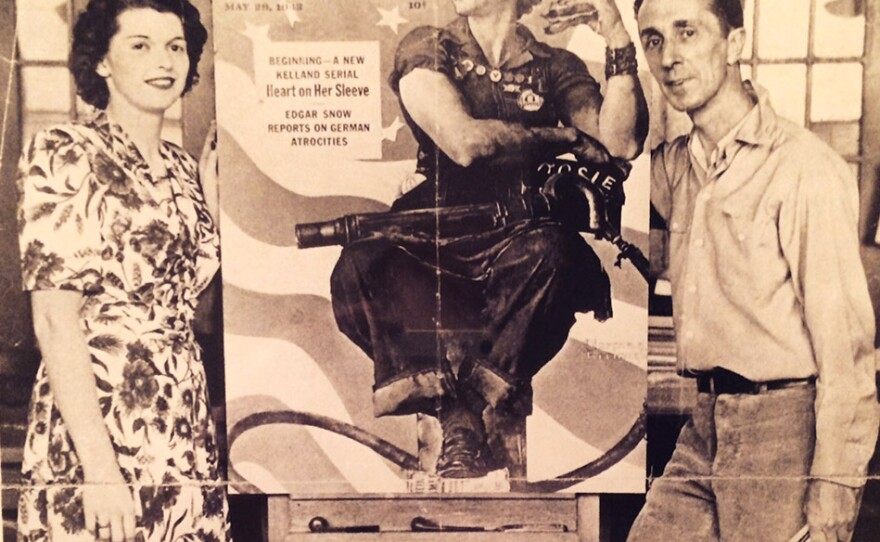The popular image empowered women to see their jobs as a civic service during World War II.
It would have been difficult for 19-year-old Mary Doyle Keefe to realize the incredible influence she would have on women when she sat to have her portrait painted by Norman Rockwell in the early 1940s.
Keefe, the model for Norman Rockwell’s iconic “Rosie the Riveter” painting, and resident of Simsbury, Connecticut, passed away the morning of Tuesday, April 21, 2015, at age 92.
“She passed peacefully …strong, resilient and with dignity, similar to how she lived her long and fulfilled life,” said Keefe’s daughter, Mary Ellen Keefe.
The portrait that graced the cover of the Saturday Evening Post on Memorial Day, May 29, 1943, portrayed Keefe in front of an American flag. She was dressed in blue jean overalls, gripping a sandwich with a rivet gun across her lap, and a copy of Mein Kamph beneath her feet. Her lunch box had “Rosie” written on it, and her pose was almost identical to Michelangelo’s Isaiah on the ceiling of the Sistine Chapel.
The widely-distributed patriotic image became a symbol for the millions of American women who worked in shipyards, factories, and power plants during World War II to replace male workers who had gone into the military.
“Rosie the Riveter is an everlasting symbol of feminine bravery, strength and beauty, and I see this reflected in my grandmother,” said Hillary Fortin, Keefe’s granddaughter. “Her legacy is, and will continue to be, an inspiration for women everywhere.”
Keefe lived in Arlington, Vermont, when Rockwell asked her to sit for the painting.
“She was a telephone operator at the time, which was operated out of her mother's home,” Fortin said. “Rockwell's home and studio were nearby, and he would frequently visit the office to pay his bill.”
Rockwell, who was a struggling artist at the time, asked Keefe to sit twice for the portrait and paid her a total of $10.00.
“She always said she never thought much of her experience, and never expected the painting to become so famous,” Fortin said.
Rosie’s face and red hair were accurate in the depiction, but Rockwell exaggerated her muscles and figure. Keefe didn’t know how the image would look until it was revealed.
“Years later, Norman Rockwell sent my grandmother a sweet typed letter apologizing for making her appear so large,” said Fortin. “He claimed he had embellished her build, but really thought she was the most beautiful woman he had ever seen.” The Saturday Evening Post donated the painting to the Second War Loan Drive to raise money and awareness for the war effort.
During the war, women were often not able or willing to participate in hands-on factory jobs typically done by men. Women who did such jobs were seen as less feminine than those who stayed at home. Popular images such as “Rosie the Riveter” empowered women to see these jobs as a civic service to their country, and as their role to support the war. The image of Keefe inspired women to become real-live “Rosies” themselves.
Keefe was described as a very gracious and independent woman. After the painting became famous, she received much gratitude and praise.
In 1994, Keefe was a guest on “Good Morning America” and “The Tonight Show” with Jay Leno, honoring the 50th anniversary of D-day. When “The Tonight Show” producer called Keefe, she thought the person on the phone was her son fooling around, and nearly hung up on him.
Before his death in 2003, Keefe's husband Robert would regularly joke about being her agent.

Keefe’s image was not only mass distributed as the cover of a national magazine, but also widely produced on posters, mugs, t-shirts, paint-by-numbers, flasks, snow globes, plates, and Christmas ornaments.
Keefe’s family continues an annual Yankee swap at Christmas time when most gifts are related to Rosie the Riveter.
“She was proud of what she represented, but was always humble and modest about the attention,” said Mary Ellen Keefe. “One Veteran’s Day, she spoke at my daughter Sarah Fortin’s school, and the conversation became so much about her experience as a model that she deflected the attention to the veterans, and her husband -- my dad -- who was a World War II captain in the Air Force.”

Keefe’s portrait is often confused with J. Howard Miller’s “We Can Do It!” poster. That poster became popular in the early 1980s and is often referred to as Rosie the Riveter. Thought to be produced from a photograph of Geraldine Hoff Doyle, the poster was used to improve worker morale and promote feminism and other political issues.
In 2001, the original Rosie the Riveter painting was on loan to the Norman Rockwell Museum, in Stockbridge, Massachusetts. Keefe had a great relationship with the Norman Rockwell Museum, where she would speak at Model Reunions. Mary Ellen said they “treated her like gold.” In 2002, the painting was auctioned off at Sotheby’s to a gallery in Aspen, Colorado for $4.9 million. At the time, this was the highest price paid in auction for a Rockwell original. The painting is now part of the permanent collection at the Crystal Bridges Museum of Art in Bentonville, Arkansas.
These days, most magazine companies choose to glamorize their cover models. Rockwell did the reverse when he painted Mary Doyle Keefe. It is easy to see the tough exaggerations in her physique; however he used subtle symbolism to make his statement. In the pocket of her dirty blue dungarees is a lace-fringed handkerchief and a white-trimmed gold compact. On her head, in addition to a pair of goggles and a protective mask, is a halo.
“She was an incredible role model for women -- especially my daughters,” said Mary Ellen. “She showed how they can be strong and independent while still being feminine and gentle.”






